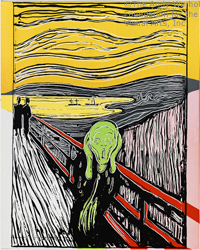The Scream (after Munch)

In 1983, Andy Warhol (1928–1987) made a series of silk-screen prints based on works by Edvard Munch. The inspiration came from a visit to a New York City art gallery in the fall of 1982 that showed over 100 works by Munch. Warhol was a great admirer of Munch, and had travelled to Norway at the end of the 1960s to view Munch’s works at the National Gallery and the Munch Museum in Oslo.
In Warhol’s early production we find not only pictures of catastrophes, well-known brand names and celebrities. He also made art from the art of others. In the same way that he had reproduced Marilyn Monroe in a new visual expression of stardom; in 1963 he made a series of pictures of Leonardo da Vinci’s canonised Mona Lisa. 20 years later he repeated the project, but this time with the Mona Lisa’s only rival on the art historical horizon: Edvard Munch’s iconic Scream.
In addition to Scream Warhol developed three other important works by Munch: Madonna, Self-portrait with Skeletal Arm and Eva Mudocci, also called The Brooch. His choice of these particular motifs is not so difficult to understand. Scream had become world famous and was generally considered as an expression of angst produced by the modern age. Eva Mudocci is perhaps Munch’s most classical portrait of a beauty and might even be called “Munch’s Marilyn”, while the dual subjects of Madonna and the sombre Self-portrait with Skeletal Arm seem to summarize the themes that dominated his series of paintings called the Frieze of Life: life, death and love.
Warhol’s rendering of Scream is an energetic Pop version of the motif. Warhol amplifies the image’s inherent sense of (now almost legendary) disturbing anxiety. Scream has since become a regular little business in itself, with a large assortment of items and popular products containing the image, in the spirit of Warhol himself! Warhol’s version was first in line as a declaration of admiration and respect for Munch – and perhaps also as a tongue in cheek commentary on his angst-ridden worldview.
Together with the Munch Museum, Lillehammer Art Museum and Haugar Art Museum, we have the pleasure of presenting an exhibition where Warhol and Munch meet. The exhibition shows a number of Warhol’s Munch adaptations together with Munch’s own prints of the same motifs. “Munch by Warhol” opens at Haugar Art Museum on 22 May and will later be on view at Lillehammer Art Museum.
AB